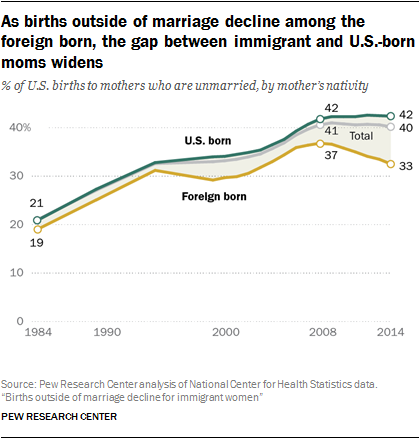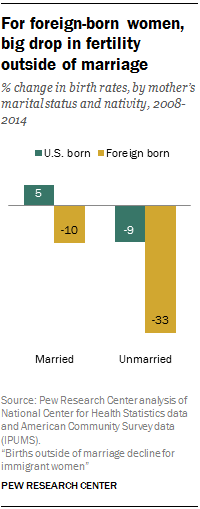Welp immigrants are learning something that Black Americans lost 2 generations ago and that most Americans no longer value; marriage is important when creating families. So why you are degreed and raising kids alone or a man paying child support...
Long-term growth in total U.S. births driven by the foreign born, who account for 23% of all babies

After rising for decades, the share of U.S. babies born to unmarried women has stabilized in recent years, driven by a sharp decline in births outside of marriage among foreign-born women, and a leveling off among U.S.-born women.
 In the newest available data (2014), a third of all births to foreign-born mothers were to unmarried women – down from a peak of 37% in 2008. At the same time, the rate has held steady for U.S.-born women and now stands at 42%, according to a new Pew Research Center analysis of government data.
In the newest available data (2014), a third of all births to foreign-born mothers were to unmarried women – down from a peak of 37% in 2008. At the same time, the rate has held steady for U.S.-born women and now stands at 42%, according to a new Pew Research Center analysis of government data.
The share of babies born to unmarried mothers has consistently been higher for U.S.-born women than for immigrant women. However, the roughly 10-point gap1 between the two groups in 2014 is the largest disparity since birth data by nativity and marital status became available 30 years earlier.
The share of all babies born to unmarried women in the U.S. stood at 40% in 2014, down marginally from 41% in 2008, according to the National Center for Health Statistics. Thirty years earlier, just 21% of babies were born to unmarried women.
The decline in births outside of marriage among the foreign born is being driven, in part, by the changing regions of birth of new foreign-born mothers. The share of babies born to moms from Latin America has declined, while the share of babies born to moms from regions such as Asia has increased. New foreign-born mothers from Latin America were roughly four times as likely as moms from Asia to be unmarried in 2014.
The shifting origins of new immigrant mothers are due in part to the decline in the number of recent U.S. immigrants from Latin America, which has been driven largely by post-recession declines in Mexican immigrants, and to dramatic birth rate declines among Hispanic immigrants in the wake of the Great Recession.
 Plummeting fertility rates among unmarried foreign-born women are further contributing to the declining share of babies born outside of marriage for this group. In 2014 the birth rate (the annual number of births per 1,000 women of childbearing age)2 for unmarried immigrants was 60.4. This is down from 90.0 in 2008 – a drop of 33% in just six years. Fertility among married foreign-born women also declined during this period marked by the onset of the Great Recession, but by a relatively modest 10%, from 115.1 to 104.0.
Plummeting fertility rates among unmarried foreign-born women are further contributing to the declining share of babies born outside of marriage for this group. In 2014 the birth rate (the annual number of births per 1,000 women of childbearing age)2 for unmarried immigrants was 60.4. This is down from 90.0 in 2008 – a drop of 33% in just six years. Fertility among married foreign-born women also declined during this period marked by the onset of the Great Recession, but by a relatively modest 10%, from 115.1 to 104.0.
In 2014, U.S. births to foreign-born women from Latin America were more likely to occur outside of marriage than those to U.S.-born women (48% vs. 42%). However, U.S. births to foreign-born women from most other regions of the world were less likely to occur outside of marriage than those to U.S.-born women.
Read more here: Births Outside of Marriage Decline for Immigrant Women
Long-term growth in total U.S. births driven by the foreign born, who account for 23% of all babies

After rising for decades, the share of U.S. babies born to unmarried women has stabilized in recent years, driven by a sharp decline in births outside of marriage among foreign-born women, and a leveling off among U.S.-born women.
 In the newest available data (2014), a third of all births to foreign-born mothers were to unmarried women – down from a peak of 37% in 2008. At the same time, the rate has held steady for U.S.-born women and now stands at 42%, according to a new Pew Research Center analysis of government data.
In the newest available data (2014), a third of all births to foreign-born mothers were to unmarried women – down from a peak of 37% in 2008. At the same time, the rate has held steady for U.S.-born women and now stands at 42%, according to a new Pew Research Center analysis of government data.The share of babies born to unmarried mothers has consistently been higher for U.S.-born women than for immigrant women. However, the roughly 10-point gap1 between the two groups in 2014 is the largest disparity since birth data by nativity and marital status became available 30 years earlier.
The share of all babies born to unmarried women in the U.S. stood at 40% in 2014, down marginally from 41% in 2008, according to the National Center for Health Statistics. Thirty years earlier, just 21% of babies were born to unmarried women.
The decline in births outside of marriage among the foreign born is being driven, in part, by the changing regions of birth of new foreign-born mothers. The share of babies born to moms from Latin America has declined, while the share of babies born to moms from regions such as Asia has increased. New foreign-born mothers from Latin America were roughly four times as likely as moms from Asia to be unmarried in 2014.
The shifting origins of new immigrant mothers are due in part to the decline in the number of recent U.S. immigrants from Latin America, which has been driven largely by post-recession declines in Mexican immigrants, and to dramatic birth rate declines among Hispanic immigrants in the wake of the Great Recession.
 Plummeting fertility rates among unmarried foreign-born women are further contributing to the declining share of babies born outside of marriage for this group. In 2014 the birth rate (the annual number of births per 1,000 women of childbearing age)2 for unmarried immigrants was 60.4. This is down from 90.0 in 2008 – a drop of 33% in just six years. Fertility among married foreign-born women also declined during this period marked by the onset of the Great Recession, but by a relatively modest 10%, from 115.1 to 104.0.
Plummeting fertility rates among unmarried foreign-born women are further contributing to the declining share of babies born outside of marriage for this group. In 2014 the birth rate (the annual number of births per 1,000 women of childbearing age)2 for unmarried immigrants was 60.4. This is down from 90.0 in 2008 – a drop of 33% in just six years. Fertility among married foreign-born women also declined during this period marked by the onset of the Great Recession, but by a relatively modest 10%, from 115.1 to 104.0.In 2014, U.S. births to foreign-born women from Latin America were more likely to occur outside of marriage than those to U.S.-born women (48% vs. 42%). However, U.S. births to foreign-born women from most other regions of the world were less likely to occur outside of marriage than those to U.S.-born women.
Read more here: Births Outside of Marriage Decline for Immigrant Women